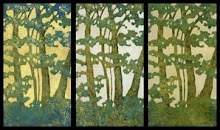As usual, each one is different and some I like more than others. Basically, though, they all resemble this one with a light spot on the left and in the road. I'm using Akua Kolor water based inks and thinning them out with their Blending Medium. I started out the same way as with the monotype in my previous post. The first impression consisted of mainly Yellow Ochre brushed thinly over the entire block, wiped away gently in the areas that were to remain light, and then feathered out. The second impression was done with a Raw Umber/Burnt Sienna mixture applied to the darker areas and then feathered into the light area, and the third was some mixture Phalo Blue and who knows what else.
I have a little bit of a color problem. I'm a mixer. I mix in the palette tray I am using and I mix it on the block and sometimes I even mix it on the brush. And then when I print, I mix it up differently for the next one because I just want to see what it would look like if I added just a dab of something else. But it doesn't just apply to printing. It is habitual.
I go to paint a wall in my house and stare at paint chips for hours until I've picked out the perfect color. Once I'm home I do a test strip on the wall and realize it just isn't quite right, and then I start adding things to it. Anything. A little bit of acrylic or gouache from a tube. A little bit of the paint I added stuff to the last time I painted a wall. Then, all of a sudden, it is just the color I was looking for. The only real problem comes when I don't have enough and have to match it, which has happened more than once, but somehow I manage to do it again. Or start over.
Anyway, I had this revelation while I was printing these backgrounds and thinking about my mixing issues and controlling them by trying to make 12 prints that look the same as far as color, because I had tried to keep the first 2 or 3 the same. I remembered a conversation I had with an abstract painter at my office. I was showing him a few of my prints on the internet and describing the process involved. He commented on the fact that he could never plan ahead in the manner that one has to plan ahead to do a print, and that his artwork was more spontaneous. As the conversation progressed, we started talking about color, and he went on and on about color wheels and values and hues and names and knowing what was going to be used going in. He controls the color so the shape can be spontaneous.
After thinking about it for a while, I started thinking there wasn't much difference between my planning ahead and his. I just want to play with the color. I don't want to think about what it's name or number is or keep track of how I made it, I just want to mix it and layer it until it just feels right. I don't even think about it when I'm doing it, I'm just enjoying watching it happen. And maybe that's what printmaking is for me. I control the shape so the color can be spontaneous.


4 comments:
You've given an outstanding explanation of what is going on here...thank you for sharing...and looking forward to the next step
So that's what it's called -- "mixing issues." You have beautiful mixing issues.
Love your story about the painter and his color wheel. I think that "spontaneity" in art is mostly a myth. But I like your thought that exerting control in one area allows for more freedom to experiment and be spontaneous in another area.
Nice post.
Thanks for the comments Nighthawk, Annie and Annette.
And Annie, maybe spontaneity isn't quite the right word I'm looking for. You know the feeling. I can tell by the way you write. It's that moment where you think about every word carefully as opposed to that moment where the words just flow, and you don't even think about it. It just happens. My mother, who is quite the artist herself, refers to it as "When the muse hits."
You can't harness it, you don't know when it will happen, it's just a moment in time where you are lost in what you are doing that nothing else in the world exists. It is almost perfect.
Post a Comment